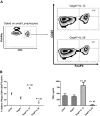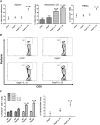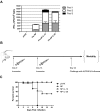Comparative ability of IL-12 and IL-28B to regulate Treg populations and enhance adaptive cellular immunity
- PMID: 19304955
- PMCID: PMC2700323
- DOI: 10.1182/blood-2008-11-190520
Comparative ability of IL-12 and IL-28B to regulate Treg populations and enhance adaptive cellular immunity
Abstract
Improving the potency of immune responses is paramount among issues concerning vaccines against deadly pathogens. IL-28B belongs to the newly described interferon lambda (IFNlambda) family of cytokines, and has not yet been assessed for its potential ability to influence adaptive immune responses or act as a vaccine adjuvant. We compared the ability of plasmid-encoded IL-28B to boost immune responses to a multiclade consensus HIV Gag plasmid during DNA vaccination with that of IL-12. We show here that IL-28B, like IL-12, is capable of robustly enhancing adaptive immunity. Moreover, we describe for the first time how IL-28B reduces regulatory T-cell populations during DNA vaccination, whereas IL-12 increases this cellular subset. We also show that IL-28B, unlike IL-12, is able to increase the percentage of splenic CD8(+) T cells in vaccinated animals, and that these cells are more granular and have higher antigen-specific cytolytic degranulation compared with cells taken from animals that received IL-12 as an adjuvant. Lastly, we report that IL-28B can induce 100% protection from mortality after a lethal influenza challenge. These data suggest that IL-28B is a strong candidate for further studies of vaccine or immunotherapy protocols.
Figures







Similar articles
-
Comparative ability of plasmid IL-12 and IL-15 to enhance cellular and humoral immune responses elicited by a SIVgag plasmid DNA vaccine and alter disease progression following SHIV(89.6P) challenge in rhesus macaques.Vaccine. 2007 Jun 21;25(26):4967-82. doi: 10.1016/j.vaccine.2006.11.070. Epub 2007 Feb 14. Vaccine. 2007. PMID: 17335943
-
Improvement in T helper 1-related immune responses in BALB/c mice immunized with an HIV-1 gag plasmid combined with a chimeric plasmid encoding interleukin-18 and flagellin.Microbiol Immunol. 2015 Aug;59(8):483-94. doi: 10.1111/1348-0421.12274. Microbiol Immunol. 2015. PMID: 26094825
-
Resiquimod is a modest adjuvant for HIV-1 gag-based genetic immunization in a mouse model.Vaccine. 2004 Apr 16;22(13-14):1782-90. doi: 10.1016/j.vaccine.2004.01.037. Vaccine. 2004. PMID: 15068862
-
IL-15 expression plasmid enhances cell-mediated immunity induced by an HIV-1 DNA vaccine.Vaccine. 1999 Feb 26;17(7-8):858-66. doi: 10.1016/s0264-410x(98)00271-0. Vaccine. 1999. PMID: 10067692
-
Cimetidine enhances immune response of HBV DNA vaccination via impairment of the regulatory function of regulatory T cells.Biochem Biophys Res Commun. 2008 Aug 1;372(3):491-6. doi: 10.1016/j.bbrc.2008.04.191. Epub 2008 May 23. Biochem Biophys Res Commun. 2008. PMID: 18502198
Cited by
-
Intratumoral IL-28B Gene Delivery Elicits Antitumor Effects by Remodeling of the Tumor Microenvironment in H22-Bearing Mice.J Immunol Res. 2022 Jul 28;2022:1345971. doi: 10.1155/2022/1345971. eCollection 2022. J Immunol Res. 2022. PMID: 35935577 Free PMC article.
-
Interleukin gene polymorphisms and susceptibility to HIV-1 infection: a meta-analysis.J Genet. 2018 Mar;97(1):235-251. J Genet. 2018. PMID: 29666343
-
Interleukin-28 as a Promising Marker for Predicting Invasive Mechanical Ventilation Requirement and Mortality in COVID-19 Patients.Thorac Res Pract. 2023 Mar;24(2):61-65. doi: 10.5152/ThoracResPract.2023.22146. Thorac Res Pract. 2023. PMID: 37503641 Free PMC article.
-
Augmented immunogenicity of the HPV16 DNA vaccine via dual adjuvant approach: integration of CpG ODN into plasmid backbone and co-administration with IL-28B gene adjuvant.Virol J. 2025 Jan 8;22(1):3. doi: 10.1186/s12985-024-02604-7. Virol J. 2025. PMID: 39780219 Free PMC article.
-
Chemokine-adjuvanted electroporated DNA vaccine induces substantial protection from simian immunodeficiency virus vaginal challenge.Mucosal Immunol. 2016 Jan;9(1):13-23. doi: 10.1038/mi.2015.31. Epub 2015 May 6. Mucosal Immunol. 2016. PMID: 25943275 Free PMC article.
References
-
- Greenland JR, Letvin NL. Chemical adjuvants for plasmid DNA vaccines. Vaccine. 2007;25:3731–3741. - PubMed
-
- Hokey DA, Weiner DB. DNA vaccines for HIV: challenges and opportunities. Springer Semin Immunopathol. 2006;28:267–279. - PubMed
-
- Ank N, West H, Paludan SR. IFN-lambda: novel antiviral cytokines. J Interferon Cytokine Res. 2006;26:373–379. - PubMed
-
- Mennechet FJ, Uze G. Interferon-lambda-treated dendritic cells specifically induce proliferation of FOXP3-expressing suppressor T cells. Blood. 2006;107:4417–4423. - PubMed
Publication types
MeSH terms
Substances
LinkOut - more resources
Full Text Sources
Other Literature Sources
Research Materials

